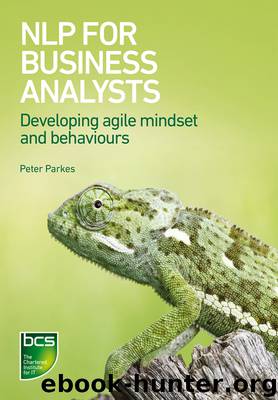NLP for Business Analysts - Developing agile mindset and behaviours by Peter Parkes

Author:Peter Parkes [Peter Parkes]
Language: eng
Format: epub
Tags: Business, Business Communication
Publisher: BCS Learning & Development Limited
Published: 2016-10-23T16:00:00+00:00
How does that sound to you? Does it influence you to think that I am competent? How long did that take, less than a minute? (Sometimes I would ramble when asked these questions at an interview, so it is a great structure for me.) Think of a message that you want to get over and practice writing/telling it in this STAR format.
3.12.2 Use of ambiguity to gain agreement
Storytelling reveals meaning without committing the error of defining it.
Hannah Arendt, political philosopher
If you want to engage people, and also get them to agree with you, be specific about immaterial things, but use ambiguous terminology where people might associate values and beliefs. This, alongside storytelling and metaphor, is one tool which accomplished politicians, and lawyers versed in the art of rhetoric, use to influence people. We might all agree that ‘education is good’, but if you go into specifics like ‘online training is good’, then you run the risk of people disagreeing with you. This is especially true in a group, where they will not agree amongst themselves on specifics and your first task is to get general agreement of direction of travel before considering options.
In the early days of NLP, the founders derived the meta-model for specific questioning by modelling the renowned hypno-therapist Milton Erickson. Erickson used what was described as ‘artfully vague language’ to persuade mentally ill people to become well again. It can also be used to help mentally tired people to see clearly.
An over the top example of its use might be something like:
The decision to move forward can only be a good thing. People are behind this. It means we can increase performance and become more competitive while reducing inefficiency. The problems of the past will be behind us as we create new capabilities which give us a competitive edge. Let’s do it now.
All great empowering words. Don’t you just want one? Would your governing body want one? Have you heard people in your organisation speaking like this? If so, they are probably on the top floors as they know how to sell a story.
By lightly applying the meta-model questions in Section 2.15, we can start to pick it apart.
The decision (nominalisation) to move forward (how?) can only be a good thing (complex equivalent – this means that, really?). Everyone (generalisation – everyone?) is behind this (what?). It means (complex equivalent) we can increase performance (lack of referential index) and become more competitive (than who?) while reducing inefficiency (inefficient at what?). The problems (which?) of the past (when?) will be behind us (who?) as we (who?) create (how?) new capabilities (which?) which give us (who specifically?) a competitive edge (lack of referential index – against who?). Let’s (who?) do it (what?) now (why?).
When the head of performance management from Rolls-Royce went back to work after attending one of my courses a few years ago, her boss, the head of capability, asked if she had been ‘programed’. ‘No’, she replied, ‘I think I have been de-programed.’
Download
This site does not store any files on its server. We only index and link to content provided by other sites. Please contact the content providers to delete copyright contents if any and email us, we'll remove relevant links or contents immediately.
Hit Refresh by Satya Nadella(9015)
The Compound Effect by Darren Hardy(8786)
Change Your Questions, Change Your Life by Marilee Adams(7610)
Nudge - Improving Decisions about Health, Wealth, and Happiness by Thaler Sunstein(7546)
The Black Swan by Nassim Nicholas Taleb(6989)
Deep Work by Cal Newport(6855)
Daring Greatly by Brene Brown(6428)
Rich Dad Poor Dad by Robert T. Kiyosaki(6361)
Principles: Life and Work by Ray Dalio(6176)
Man-made Catastrophes and Risk Information Concealment by Dmitry Chernov & Didier Sornette(5900)
Playing to Win_ How Strategy Really Works by A.G. Lafley & Roger L. Martin(5864)
Digital Minimalism by Cal Newport;(5633)
Big Magic: Creative Living Beyond Fear by Elizabeth Gilbert(5576)
The Myth of the Strong Leader by Archie Brown(5403)
The Slight Edge by Jeff Olson(5334)
Discipline Equals Freedom by Jocko Willink(5256)
The Motivation Myth by Jeff Haden(5142)
Stone's Rules by Roger Stone(5013)
The Laws of Human Nature by Robert Greene(4968)
